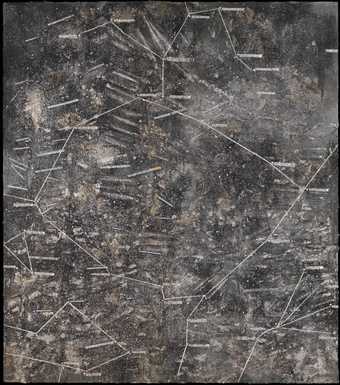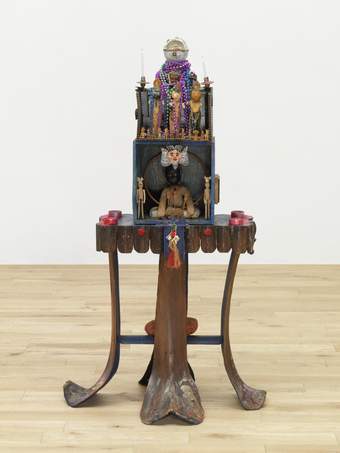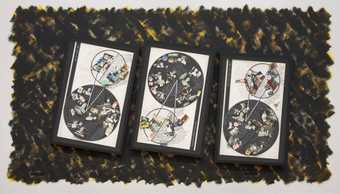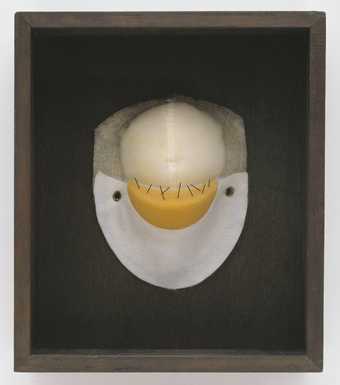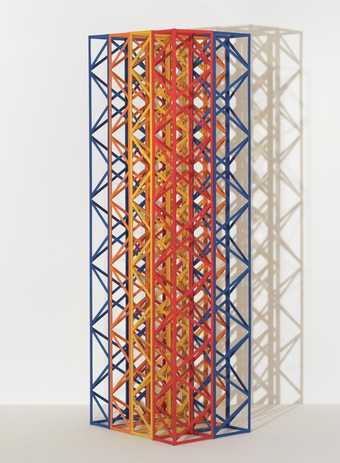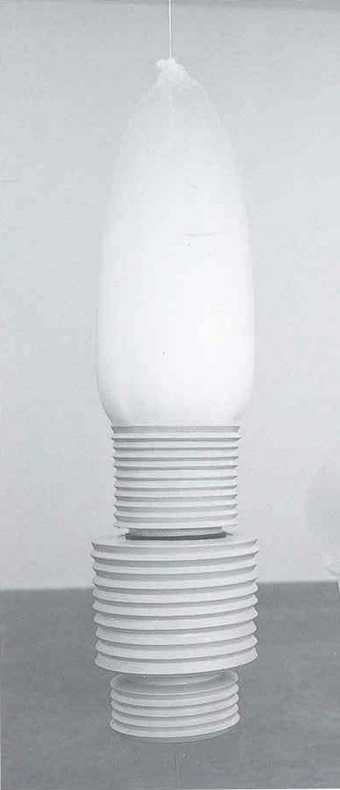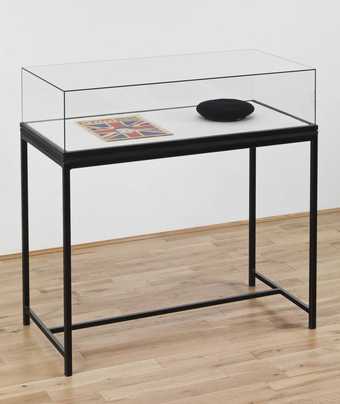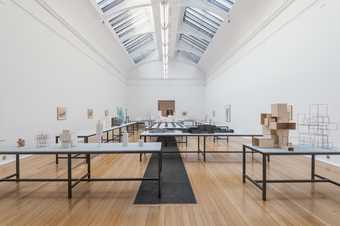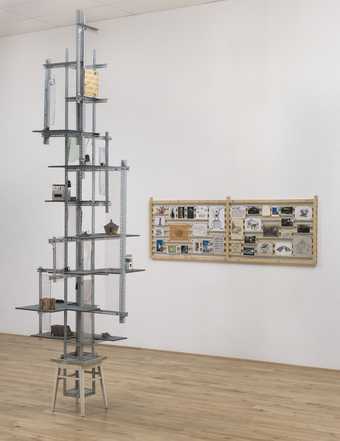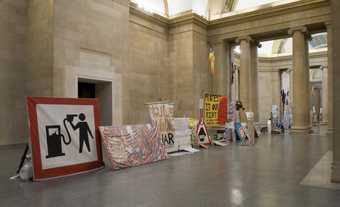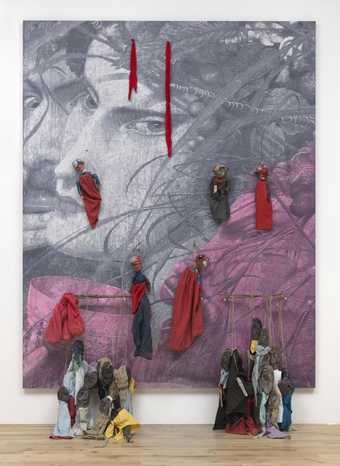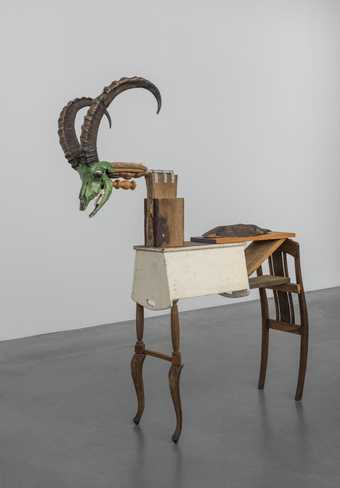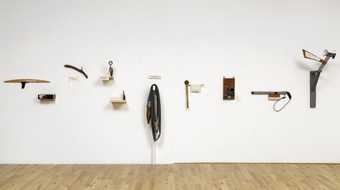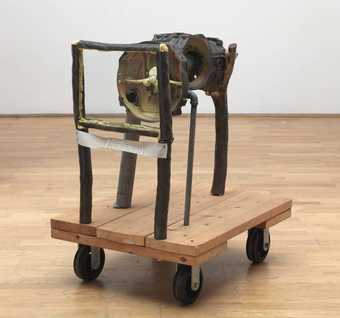Not on display
- Artist
- Huma Bhabha born 1962
- Medium
- Clay, wire, wood, bone, iron, cotton, fabric, glass, paper, headlight cover, steel, polystyrene and other materials
- Dimensions
- Object: 1650 × 1040 × 76 mm
- Collection
- Tate
- Acquisition
- Purchased with funds provided by the South Asia Acquisitions Committee 2017
- Reference
- T14936
Summary
Man of No Importance 2006 consists of a large sculptural head balanced on a simple wooden support and base. The head is constructed with found Styrofoam packaging, which has been painted and covered with a chicken wire armature and then fleshed out with red clay. Formally, the oversize bust is reminiscent of the bearded heads found on classical sculptural herms, often of Greco-Roman gods on top of a square column. In Bhabha’s sculpture, the face bears a single eye, centered on the forehead, a reference to the cyclops – giant mythological creatures who represent brute force and physical power. A hand, holding a gold-painted metal staff, appears from one side. On closer inspection, the sculpture reveals a second, hidden figure secreted within the head and visible from the back and sides of the work. This smaller figure is dressed in robes and has his head bent forward, as if in prayer. Due to the contrast in scale, the Styrofoam interior within which he is placed takes on an architectural presence, a ruin or a chapel, adding a narrative layer to the work. The artist has said about the play of scale in her works, ‘I love the idea of making something that gives the illusion of being huge, but is actually small in relation to the landscape’ (quoted in Salon 94 2010, p.77). Bhabha usually fabricates all of her own work in her studio in upstate New York, working intuitively and building each form according to a method inspired by informal urban architecture, where materials are stacked and placed and, in her words, ‘just lean against one another, touching but not attached. My whole construction process is based on this simple approach.’ (Ibid., p.79.) Man of No Importance is thus characteristic of her practice.
The title is taken from the comedy drama film (1994) directed by Suri Kishnamma and starring Albert Finney, and subsequent musical of the same name; however, Bhabha’s choice does not seem to bear any direct narrative relationship to its reference, but rather appears to refer to the dichotomy between the two figures within the sculpture.
Bhabha grew up in Karachi, Pakistan, and has acknowledged the formative influence of its arid landscape and improvised urban architecture on her practice. She was first a painter and printmaker, trained at the Rhode Island School of Design and at Columbia University, New York. She began to make sculptural work after moving to New York City in the 1990s, collecting detritus from the city streets as her material. Bhabha gravitated towards materials such as cork and Styrofoam, attracted to them as they are lightweight and can be easily manipulated, while having a bulk and mass that contradicts and belies their weight. This is a paradox she enjoys, alongside the play of scale in her work.
In Pakistan, Bhabha took photographs of the Karachi landscape, particularly of areas under construction and development. In 2011 she began an ongoing series of paintings of heads which seem part-primate, part-mask; or part-human and part-animal. Her work has been described as ‘post-apocalyptic’ (ibid., p.63), but in an interview with artist Julie Mehretu in 2010 she said, ‘I’m not trying to make post-apocalyptic work. My work is very much of the present – informed by my peers, art history, minimalism and Pop Culture.’ (Quoted in ibid., p.80.) She cites influences as diverse as Alberto Giacometti (1901–1966), Egyptian and Cambodian sculpture, science fiction, and references from television and film, particularly the Russian film maker and theorist Andrei Tarkovsky. Works such as Man of No Importance bridge these multiple temporalities, combining the everyday with the dystopian and futuristic, whilst simultaneously channeling archetypes from ancient mythology and art history.
The sculpture was shown as part of the Saatchi Collection in the exhibition USA Today: New American Art from the Saatchi Gallery, at the Royal Academy of Arts, London in 2006.
Further reading
Huma Bhabha, exhibition catalogue, Peter Blum Edition and Salon 94, New York 2010.
Huma Bhabha, exhibition catalogue, Salon 94, New York 2015.
Nada Raza
March 2017
Does this text contain inaccurate information or language that you feel we should improve or change? We would like to hear from you.
Explore
- abstraction(8,615)
-
- from recognisable sources(3,634)
-
- figure(2,270)
- formal qualities(12,454)
-
- assemblage / collage(47)
- found object / readymade(2,631)
- texture(466)
- clothing and personal items(5,879)
-
- mask(172)
- head / face(2,497)
- lifestyle and culture(10,247)
-
- science fiction(16)
- dystopia(13)
You might like
-
Anselm Kiefer Cette obscure clarté qui tombe des étoiles
1999 -
Betye Saar Mti
1973 -
Stephen Willats Are you Good Enough for the Cha Cha Cha?
1982 -
Pepe Espaliú Untitled
1988 -
Rasheed Araeen Rang Baranga
1969 -
Roger Hiorns Untitled
2003 -
Roger Hiorns Untitled
2005 -
Gavin Turk Study for Window
1991–3 -
Sir Antony Gormley OBE RA The Model Room
1994–2013 -
Tamás Kaszás Shanty Tower
2014 -
Mark Wallinger State Britain
2007 -
Monster Chetwynd Jesus and Barabbas (Odd Man Out 2011)
2018 -
Jimmie Durham Alpine Ibex
2017 -
Jimmie Durham Untitled
1993–2012


